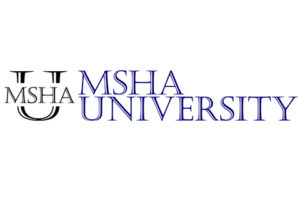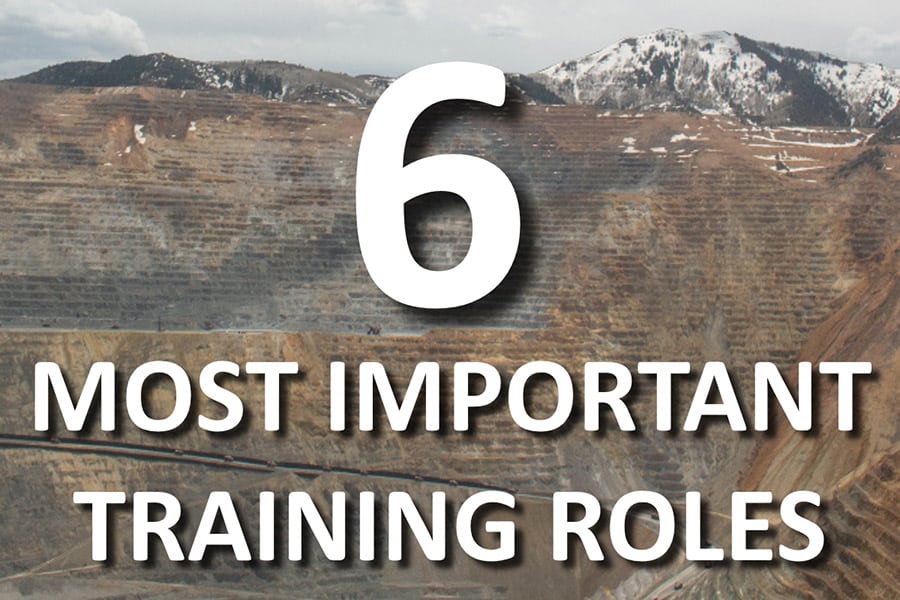MSHA training requirements can be confusing, especially for those new to the regulations. And while Part 46 for surface, nonmetal mining and Part 48 for underground coal and metal mining have some very important differences, there’s some overlap in the way MSHA defines key roles. Since lots of questions tend to arise around what these roles are and what these individuals do, I’ll spend some time going over MSHA’s official definitions and offer some insights based on input from miners in the field.
So, what are the 6 most important roles in MSHA training? The 6 most important roles in MSHA training are the:
- Miner
- Independent Contractor
- Mine Operator
- Responsible Person
- Competent Person
- MSHA-Approved Instructor
Each of these roles plays a key part in getting MSHA training done properly and producing compliant documentation. And to be honest, MSHA’s definitions are pretty straightforward. But beyond the regulations, there are some very important official interpretations of the rules for these roles and a few not-so-obvious insights that may help you stay compliant and avoid unnecessary fines. So, let’s get started with some explanations of who these people are, what they do, and why they’re so important to the MSHA training process. But first, I’ll review some differences between Part 46 and Part 48.
Important Differences Between Part 46 and Part 48
In the Code of Federal Regulations (CFR) Title 30, the U.S. federal government outlines regulations for training and retraining miners in Parts 46 and 48. But the two regulations are enforced differently and intended for different types of mining. Here’s how MSHA defines them:
- Part 46 – “The provisions of this part set forth the mandatory requirements for training and retraining miners and other persons at shell dredging, sand, gravel, surface stone, surface clay, colloidal phosphate, and surface limestone mines.”
This set of training regulations is for miners, independent contractors, and construction workers performing work at surface nonmetal, non-coal mines.
- Part 48 – “The provisions of this subpart A set forth the mandatory requirements for submitting and obtaining approval of programs for training and retraining miners working in underground mines. Requirements regarding compensation for training and retraining are also included. The requirements for training and retraining miners working at surface mines and surface areas of underground mines are set forth in subpart B of this part.”
This set of training regulations is for miners performing work at underground and surface areas of underground metal or coal mines. Part 48 also covers any surface mine (without underground operations) that extracts metal, coal, or precious stones.
Now that we’ve covered some of the basics, let’s go over these 6 important roles for complying with MSHA training regulations.
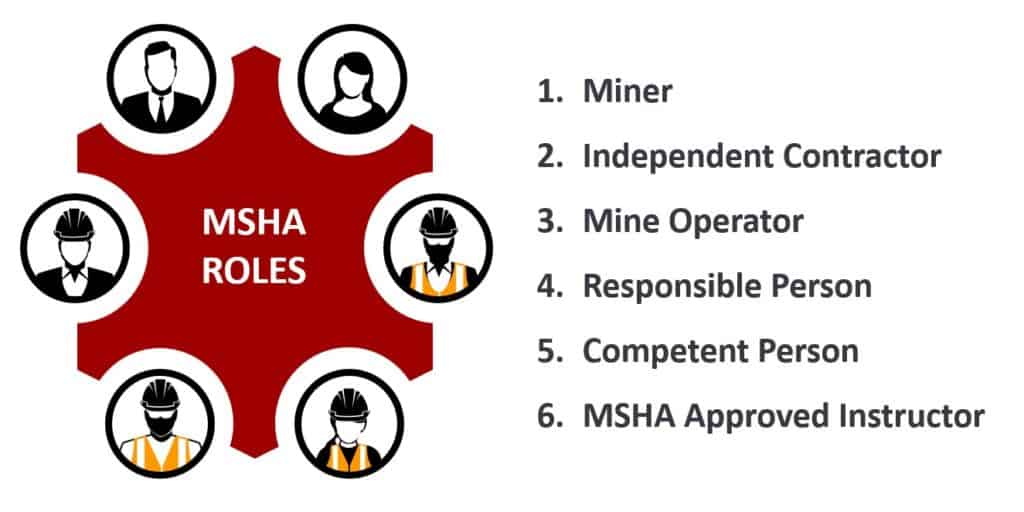
1 – The Miner
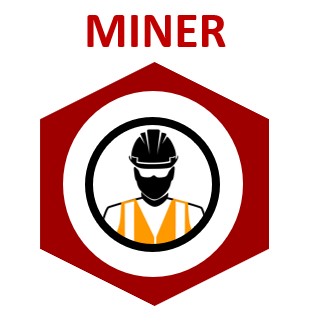
While MSHA defines the term “miner” very differently in Parts 46 and 48, ultimately, both parts share the concept that the miner is the person who is intended to receive the required training.
In Part 46.2 Definitions, MSHA defines a miner as:
- “Any person, including any operator or supervisor, who works at a mine and who is engaged in mining operations. This definition includes independent contractors and employees of independent contractors who are engaged in mining operations; and
- Any construction worker who is exposed to hazards of mining operations.”
MSHA further clarifies that the following roles are excluded from this definition of a miner.
- Scientific workers
- Delivery workers
- Customers (including commercial over-the-road truck drivers)
- Vendors
- Visitors
- Maintenance or service workers who do not work at a mine site for frequent or extended periods
You can see that the Part 46 definition of a miner is pretty direct and simple. Now, let’s take a look at Part 48’s definition.
In Part 48.2 Definitions, MSHA defines a miner as:
- “…any person working in an underground mine
and who is:
- engaged in the extraction and production process, or
- engaged in shaft or slope construction, or
- who is regularly exposed to mine hazards, or
- who is a maintenance or service worker employed by the operator or a maintenance or service worker contracted by the operator to work at the mine for frequent or extended periods.
- …the operator if the operator works underground on a continuing, even if irregular basis.
- Short-term, specialized contract workers, such as drillers and blasters, who are engaged in the extraction and production process or engaged in shaft or slope construction…
- any delivery, office, or scientific worker or
- occasional, short-term maintenance or service worker contracted by the operator, and
- any student engaged in academic projects involving his or her extended presence at the mine.”
Because Part 48 draws some lines between different subparts (A and B) and different types of training depending upon several factors, there’s a lot more to the Part 48 definition than quoted above. But I’ve provided this truncated version to give you an idea of how much more detailed and complicated Part 48 can get.
What does a miner do? – Again, aside from their differences in the regulations, the miner is required to:
- Receive the required training
- Be trained on specified subjects
- Complete minimum amounts of training
- Complete training within a specified time period
- Repeat refresher training annually
The name of each miner who receives training must appear on the 5000-23 Certificate of Training (or optional compliant record of training for Part 46). However, the miner’s signature is not required on the certificate or record of training.
2 – The Independent Contractor
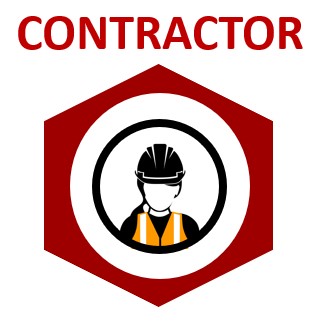
There are two important things to understand about how MSHA defines an independent contractor (mining contractors):
- If you work at a mine and are exposed to mine hazards, for practical purposes MSHA considers you a miner.
- And if MSHA considers you a miner, you need all the same training required of a miner.
Time after time, when mining contractors first talks with me, they expect me to tell them that they only need a shortened version of the required training. Unfortunately, that’s not the case. MSHA will require mining contractors to:
- Meet the same training requirements as miners, and
- Maintain all the same compliant documentation as a mine operator.
That’s a bit of a shock for mining contractors, but it’s just the way the government works. And at the end of the day, MSHA is focused on training and oversight that supports a safe work environment for everyone at a mine.
Let’s take a look at the official definitions of independent contractors for Parts 46 and 48.
Part 46 defines an independent contractor as:
- “…any person, partnership, corporation, subsidiary of a corporation, firm, association or other organization that contracts to perform services or construction at a mine… [and are] exposed to mine hazards for frequent or extended periods.”
- “Frequent” exposure is defined as a pattern of exposure to hazards at mining operations occurring intermittently and repeatedly over time. “Extended” exposure means exposure to hazards at mining operations of more than five (5) consecutive work days.
Part 48 actually doesn’t include a dedicated definition of an independent contractor in the regulations. This is in part due to the very comprehensive approach that MSHA takes with Part 48. Considering Part 48’s definition of a miner, it’s safe to assume that anyone performing work at an underground mine with be required to receive Part 48 training as a miner.
What does an independent contractor do? – Exactly the same things as a miner. Take all the same training and maintain all the same documents.
3 – The Mine Operator
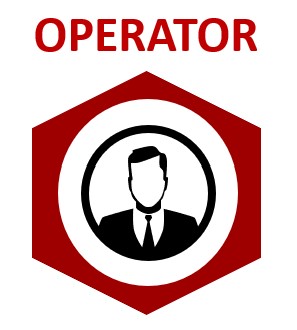
The mine operator is essentially the mine owner who’s responsible for employees at a mine.
Here’s how Parts 46 and 48 define the mine operator.
- Part 46 – “…any production-operator, or any independent contractor whose employees perform services at a mine.”
- Part 48 – “…any owner, lessee, or other person who operates, controls or supervises an underground mine; or any independent contractor identified as an operator performing services or construction at such mine.”
So in this case, they’re pretty much identical. MSHA made this one easy on us.
What does the mine operator do? – Beyond being responsible for everything (all operations and personnel) at a mine, there are a few responsibilities related to training that are important to understand. The mine operator must:
- Designate a responsible person, if not the operator, for health and safety training (Part 46 and Part 48)
- Designate competent persons who will present required training subjects to miners (Part 46)
4 – The Responsible Person

The responsible person is the individual designated by the mine operator as “responsible for health and safety training at the mine.”
This role may be the mine operator if the operator hasn’t designated anyone, or it could be an external consultant in some cases. However, it’s more common for the mine’s safety manager to be designated as the responsible person.
The responsible person must be specifically named in your training plan and that same person must sign and certify your compliant records of training. If more than one individual is designated as the responsible person, they must each be named in the training plan.
What does the responsible person do? – As the person designated responsible for health and safety training at the mine, this person must:
- Record and certify training completion for miners on the 5000-23 Certificate of Training (Part 46 and Part 48) or a compliant record of training (Part 46)
5 – The Competent Person

The concept of the competent person is specifically associated with Part 46 training. Part 46 defines the competent person as:
- “…a person designated by the production-operator or independent contractor who has the ability, training, knowledge, or experience to provide training to miners in his or her area of expertise. The competent person must be able both to effectively communicate the training subject to miners and to evaluate whether the training given to miners is effective.”
Because MSHA does not require that Part 46 training be performed by approved or certified instructors, this allows for the operator to designate who is competent to provide the training. This offers Part 46 mines a significant degree of flexibility in getting the required training done.
A Part 46 competent person can either be a mine employee or a contracted consultant from outside the mine company.
However, this person’s name (not a company name) must appear in:
- The compliant training plan associated with the subjects they’ll provide training on
- The record of training associated with the subjects they provided training on
What does the competent person do? – This role:
- Presents and oversees training in specified subjects
- Must remain available (even by phone if necessary) during online training
NOTE – There’s often confusion between the competent person and responsible person in Part 46 training, specifically when it comes to who signs the certificate or record of training. While the competent person’s name must appear on the record of training, it’s the responsible person who signs and certifies that the training is completed. However, it is possible in some cases that a single individual holds the responsibility of both roles.
6 – The MSHA-Approved Instructor
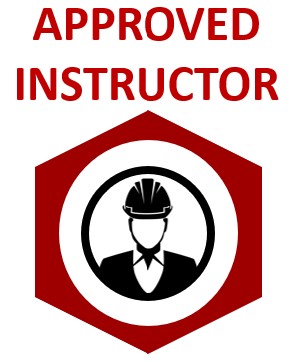
The requirement for training to be provided by an MSHA-approved instructor is specifically for Part 48 mines. For Part 46, this role is satisfied by the competent person. However, a Part 46 mine operator definitely has the authority to designate a Part 48 MSHA-approved instructor as a competent person.
In Part 48.4 – Cooperative Training Program, MSHA defines how training must be provided and by whom.
“Each program and course of instruction shall be given by instructors who have been approved by MSHA to instruct in the courses which are given, and such courses and the training programs shall be adapted to the mining operations and practices existing at the mine and shall be approved by the District Manager for the area in which the mine is located.”
This means that all Part 48 training must be provided by instructors who have successfully passed an MSHA-Approved Instructor training course.
The names of all MSHA-approved instructors, along with the courses each is approved to teach, must appear in the mine’s MSHA-approved training plan.
What does the MSHA-approved instructor do? – This person provides Part 48 training in courses they are approved to teach.
NOTE – While MSHA officially requires that Part 48 training be provided by an MSHA-approved instructor in person, there have been relatively recent allowances for Part 48 training to be provided online. However, this must be done in a way that provides trainees with real-time access to the MSHA-approved instructor.
Related Questions
Do I Need To Take BOTH Part 46 and Part 48 Training?
No. If you know that you’ll perform work at both Part 46 and Part 48 mines, you’ll only need to take Part 48 training. MSHA considers that you’ve met the Part 46 requirements if you successfully complete the much more comprehensive and strictly regulated Part 48 training.
Does A Competent Person Need To Be Certified By MSHA?
No. For Part 46 surface miner training, MSHA does not need to approve or certify instructors. The mine operator has the authority to designate personnel with “the ability, training, knowledge, or experience to provide training.”
Who Signs The 5000-23?
The responsible person. This is the person responsible for health and safety training at the mine (or mining contractor company). Many people think the instructor must sign the record of training to certify that it was completed. This is not the case. It’s the responsible person who must sign and certify that required training has been completed by a miner.
